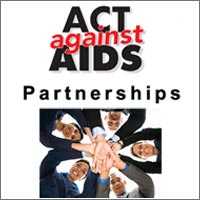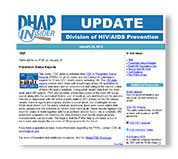Prevention Communication Branch

The Prevention Communication Branch (PCB) uses strategic communications and social marketing to influence behavior. Specifically, the branch conducts research on, develops and disseminates HIV communication products and social marketing campaigns for CDC partners, health care providers, and consumers. Key projects include social marketing campaigns for consumers and providers through the Act Against AIDS initiative, associated partnership activities and community engagement; content development and inquiry response; social media; website development; conference exhibits, and research and evaluation.
Campaigns
Act Against AIDS (AAA) is a national health communications initiative designed to refocus attention on HIV and AIDS in the United States and support the National HIV/AIDS Strategy. Launched in 2009, AAA consists of multiple campaigns for professionals, the public, and high-risk groups. The campaigns encourage testing, promote prevention, support care for people living with HIV, and address stigma and complacency. The AAA campaigns include the following:
- Doing It, a national HIV testing and prevention campaign that encourages all adults to know their HIV status and protect themselves and their community by making HIV testing a part of their regular health routine;
- Let’s Stop HIV Together, which raises HIV awareness and fights stigma among all Americans and provides many stories about people living with HIV; and
- HIV Treatment Works, a campaign that features people from across the United States who are living with HIV talking about how sticking with care and treatment helps them stay healthy, protect others, and live longer, healthier lives.
PCB’s behavioral scientists, health communication specialists, and health educators develop and implement these campaigns, including conducting formative research, testing messages with the target audiences, and evaluating the campaigns after they have launched. The branch’s staff work closely with partners to ensure the right messages reach the groups at highest risk for HIV infection.
Partnerships

The branch also attends mobilization events and conferences and partners with individuals and organizations from all sectors (arts and entertainment, business and labor, civic, social, education, faith, health, and media) to promote HIV testing, prevention and care.
Websites and Social Media Properties

CDC’s HIV site provides current, scientifically-accurate HIV content for a variety of professional and consumer audiences. The Act Against AIDS site provides access to campaign resources to targeted audiences. Also, the HIV Risk Reduction Tool helps people learn about the risk of getting HIV or transmitting HIV to someone else, and how to lower that risk.
PCB also engages with the general public, partners, and health care providers through social media, including Facebook (CDC HIV, Act Against AIDS, Start Talking. Stop HIV.), Twitter (@TalkHIV), Instagram (Act Against AIDS), and CDC’s YouTube account (CDC Streaming Health).
Internal Communications

PCB publishes a weekly newsletter, the DHAP Insider Update, to alert staff to division news, staff milestones, and updated documents. The branch also maintains the DHAP Intranet, where each branch and office has access to workplace tools and resources, including a searchable database of DHAP-authored publications.
Content Development and Inquiry Response

PCB creates a wide variety of content related to DHAP’s priorities, including fact sheets, features, infographics for partners and consumers, web content, and partner communications such as “Dear Colleague” letters. Writer-editors and health communication specialists work with other branches to interpret their guidelines, reports, and other data for various audiences.
Conference Exhibits
PCB represents DHAP at major HIV and other public health conferences. PCB’s conference support activities include: identifying key exhibiting opportunities, ordering and shipping booth materials and displays, setting up booths, and managing all logistical needs such as laptops and Internet access. Representatives from the branch staff the booths, answer questions, provide materials, and help audiences navigate online resources for information.
Research and Evaluation
PCB has a team of behavioral scientists that leads the research and evaluation activities that support the health communications activities of the branch. This includes the formative research and testing of concepts and messages with priority audiences that precedes the development and launch of a campaign to the process and outcome evaluation of campaigns after they have launched.
- Page last reviewed: April 12, 2017
- Page last updated: April 12, 2017
- Content source: Division of HIV/AIDS Prevention, National Center for HIV/AIDS, Viral Hepatitis, STD, and TB Prevention, Centers for Disease Control and Prevention


 ShareCompartir
ShareCompartir